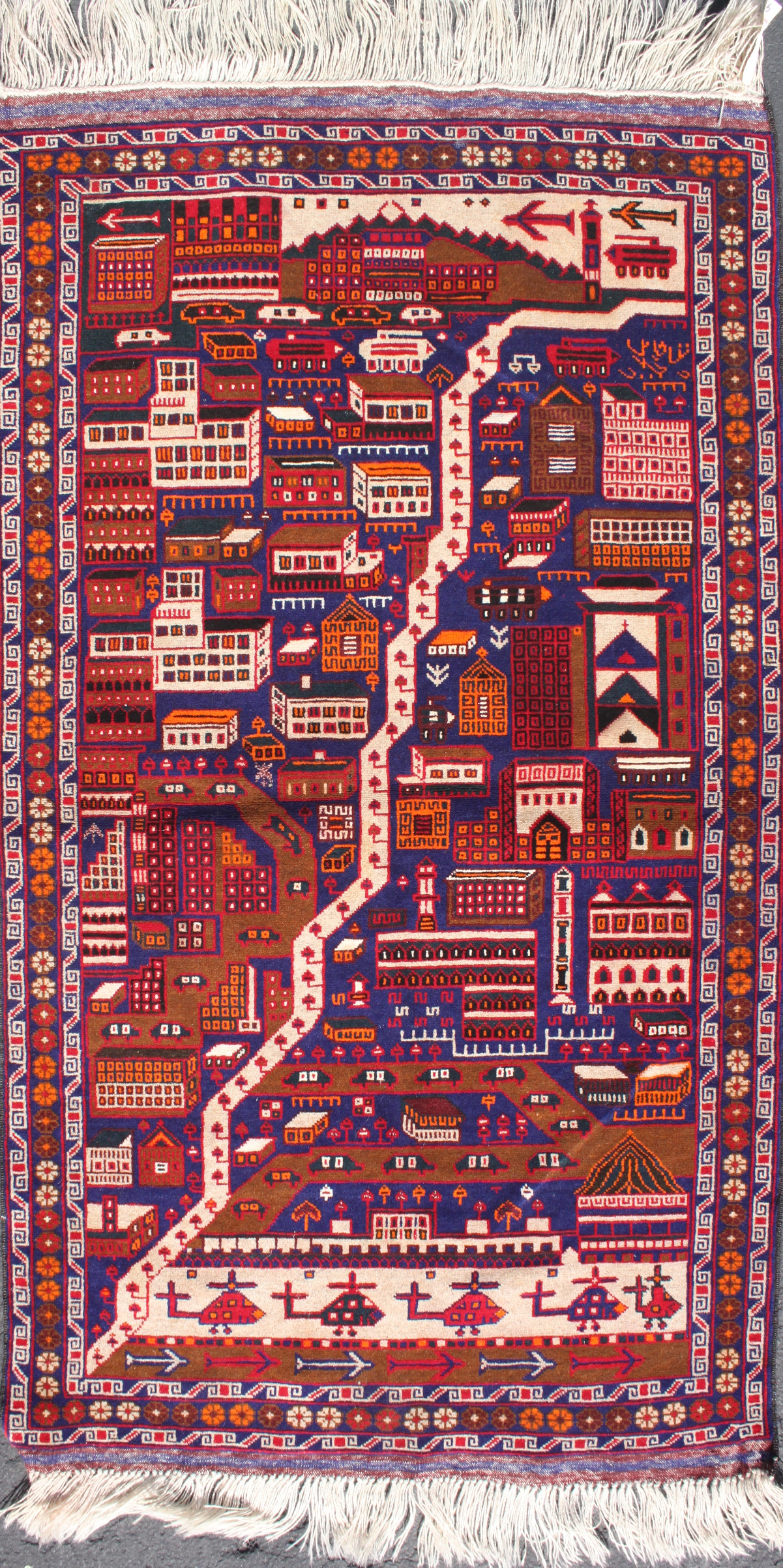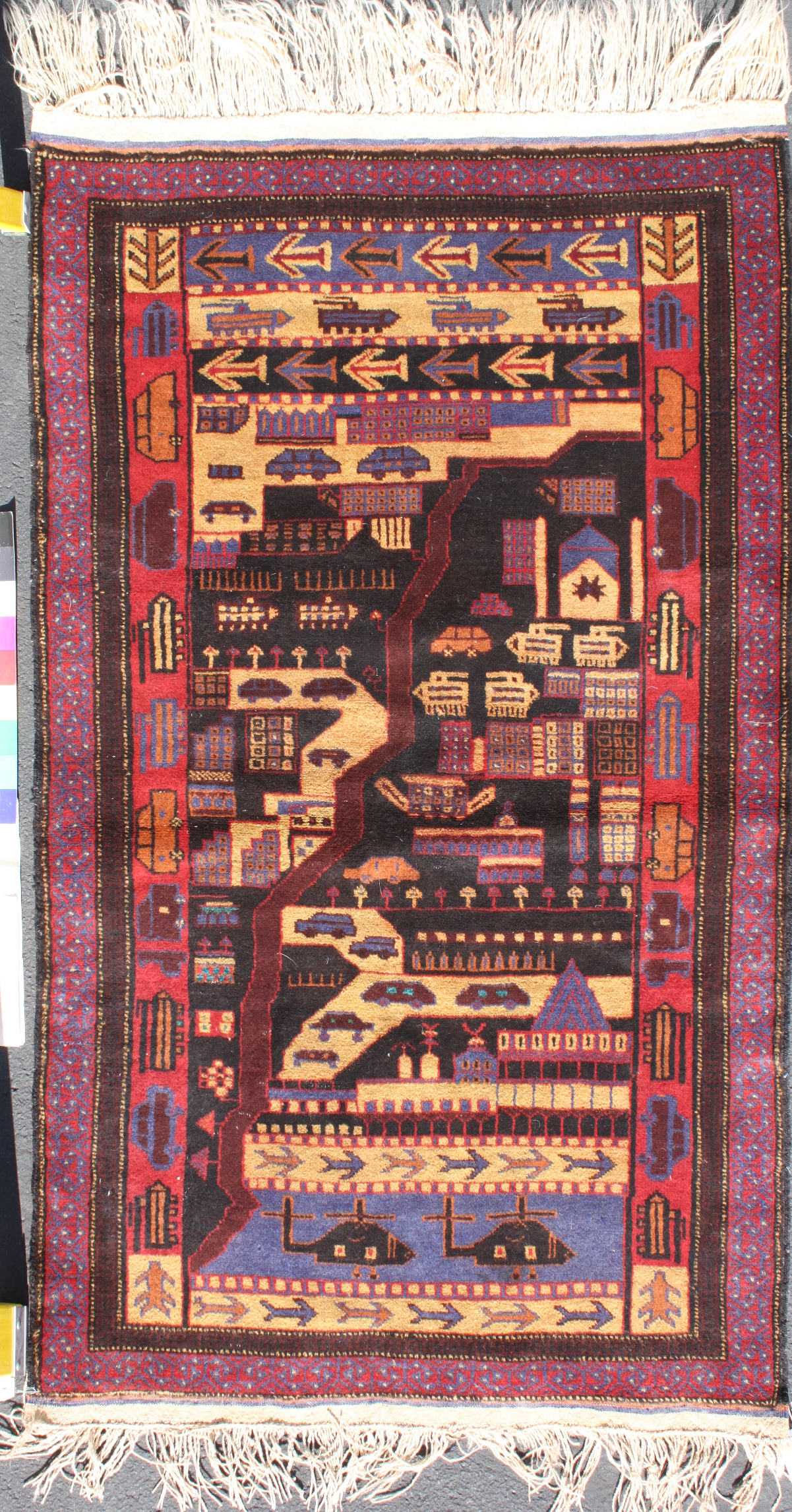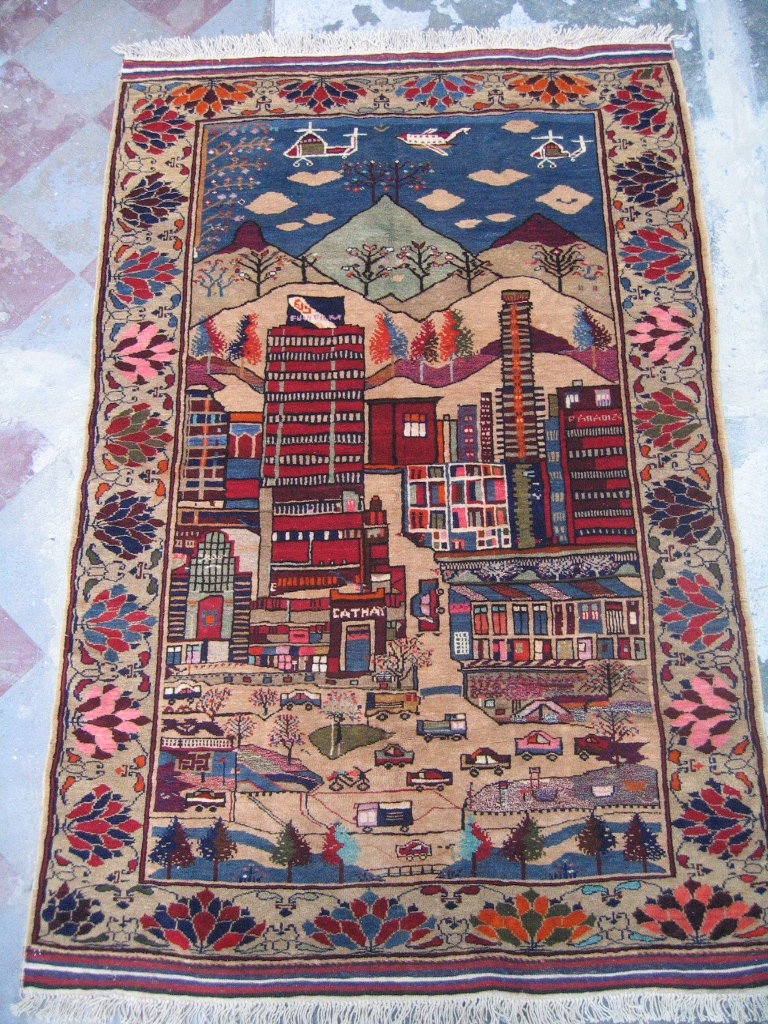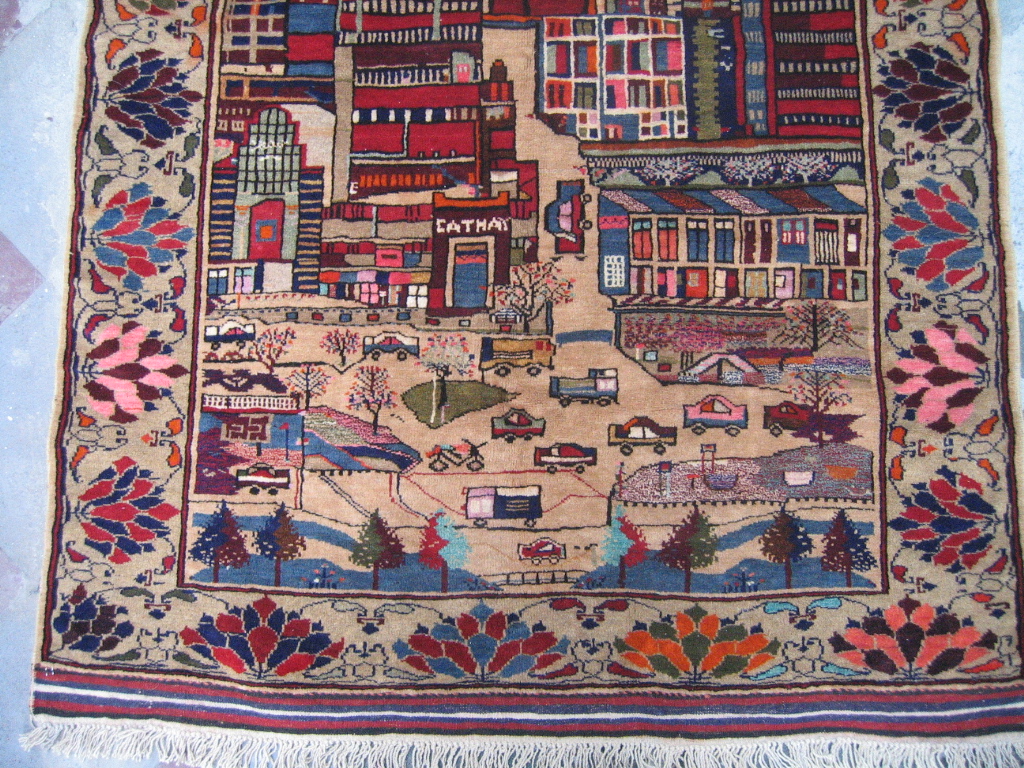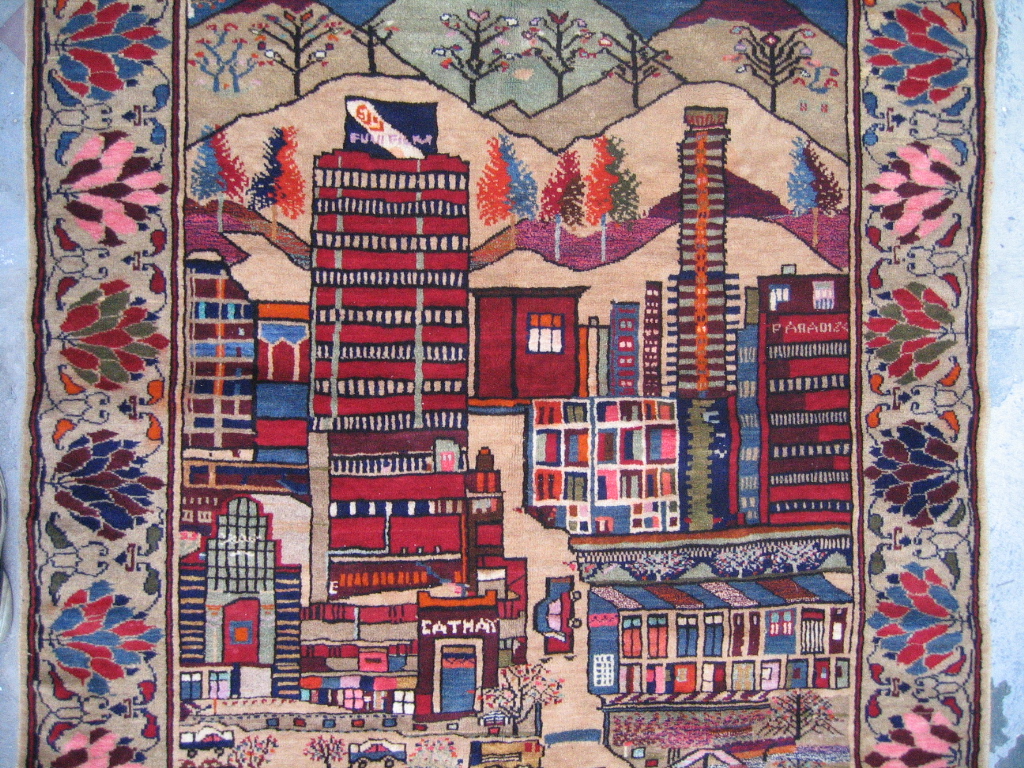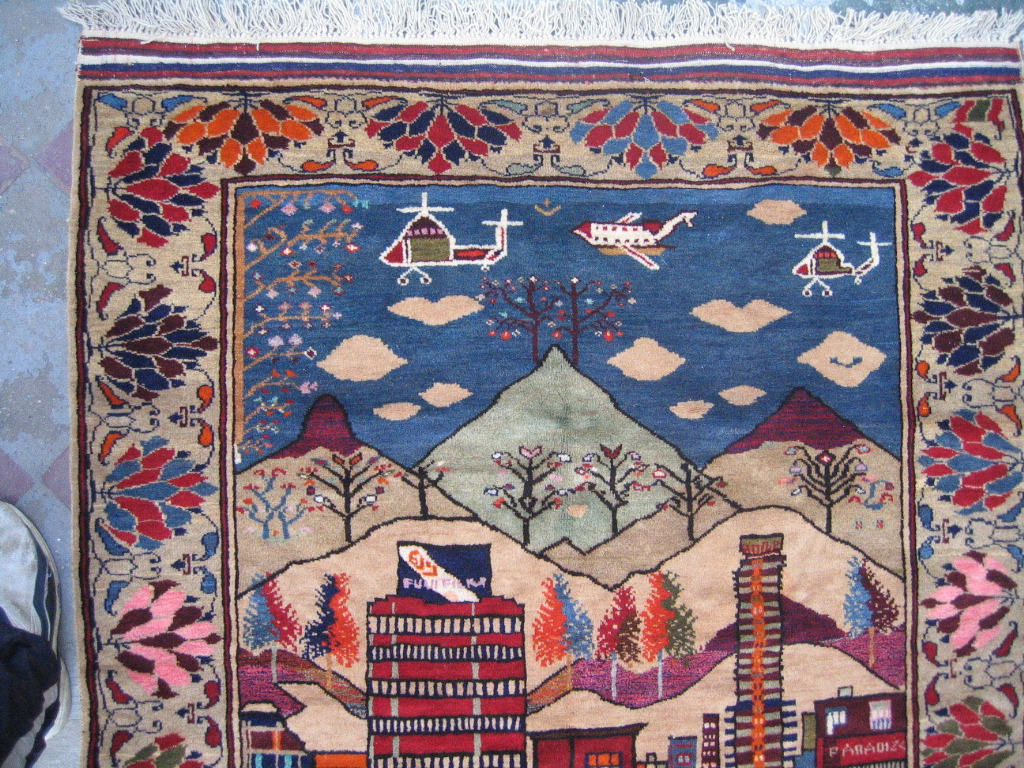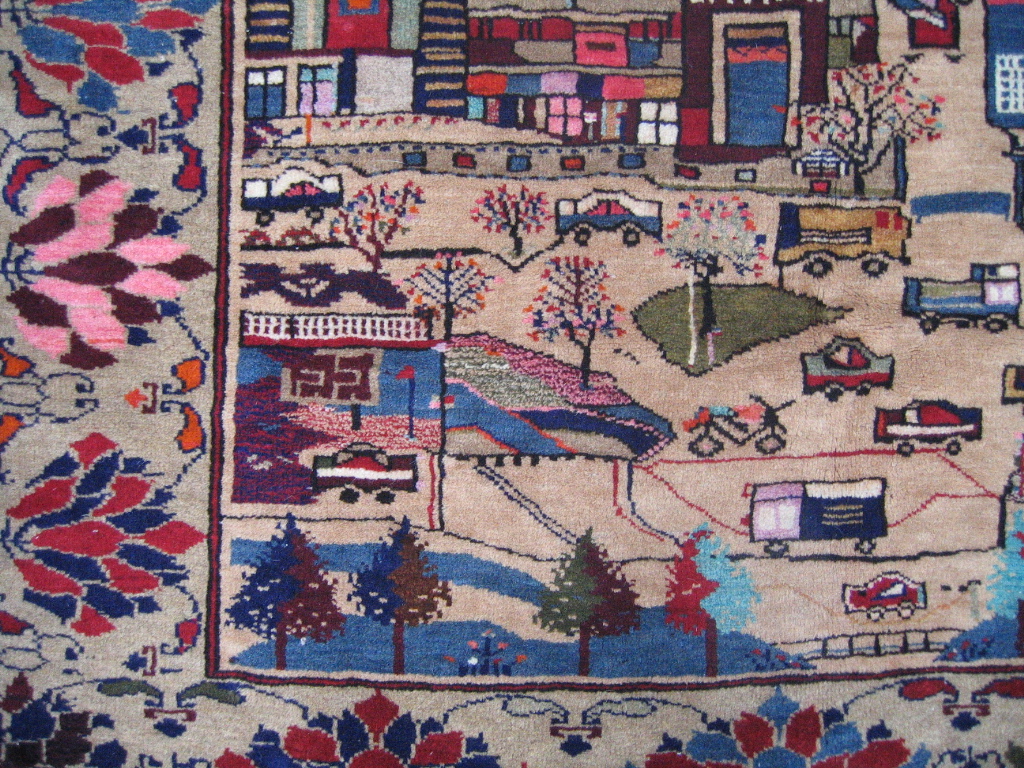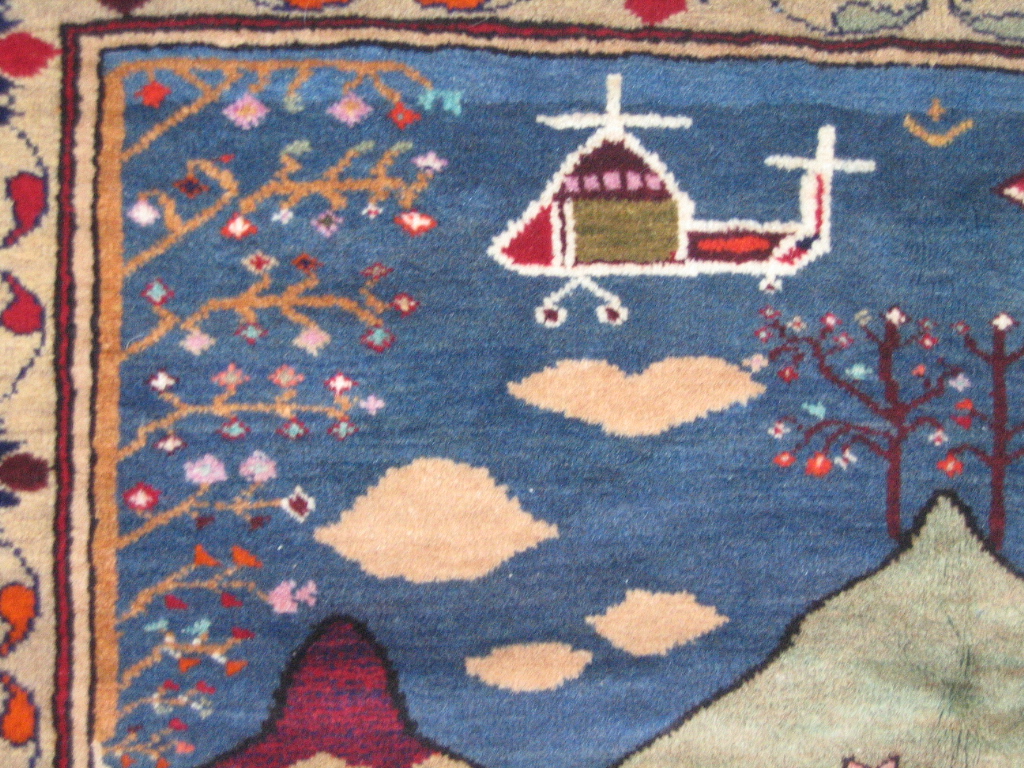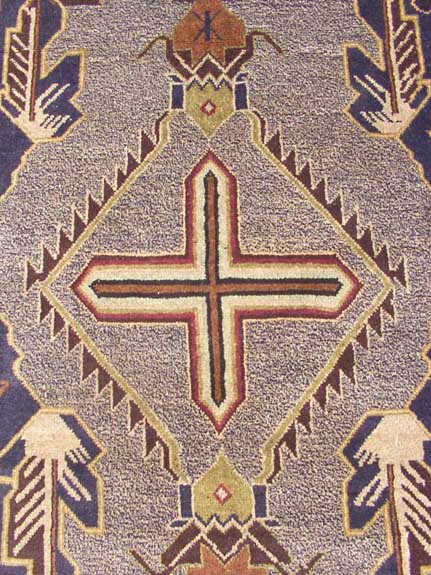Luca Emilio Brancati’s uniquely important collection
My understanding is that Luca Emilio Brancati collected war rugs from 1984 until 1987 exclusively. Thanks to Nigel Lendon, I saw a few photos over the years, but documentation of Brancati’s important 2018 exhibition at the gallery in the Palazzo Lascaris in Turin, Italy, was the first time good photos were published on the internet.




More rare photos are here, and on this FB post, and press coverage is here, and an announcement is here.
Brancati’s pinterest has lots of interesting war rug photos.
In Brancati’s new book with Amedeo Vittorio Bedini the photos alone are surely worth the thirty-four Euros.
Brancati’s last book was also a fascinating subject. Published in 1999 it seems to be out of print, but The Carpets of the Painters (or I Tappeti dei Pittori), analyzes rugs shown in old paintings.
Jamal Elias ‘ Real story behind Afghanistan’s war rugs’
University of Pennsylvania professor of Religion, Jamal Elias is an expert on visual language and material culture in the Islamic world. His book “On Wings of Diesel” is beautiful. Professor Elias has written an interesting and challenging story about war rugs which was picked up by by Fast Company , and Newsweek Japan. Professor Elias’s perspective is novel and refreshing.
A critique of war rugs presenting new perspective is appreciated, and Elias work on identity gives him a good perspective. His points about market influences are compelling, but a couple of points deserve some push-back.
There is evidence of precursor war rugs predating the Soviet invasion of Afghanistan, for example the Tabriz biplane rug in Canada’s Textile Museum collection (photo unavailable), Soviet propaganda rugs featuring Joseph Stalin, and Turkish rugs showing military aircraft.

I agree the earliest customers seem to have been NGO workers in Pakistan (and people in Boetti’s realm), and Elias characterization of the earliest rugs as ” small and shoddily made with coarse wool” may be true of early AK-47 rugs, but Luca Emilio Brancati’s exhibition in 2018 in Turin demonstrates the special beauty, idiosyncrasy, and quality of early war rugs. Photos of Brancati’s rugs are here. His collection serves as a time capsule, for it was collected exclusively between 1984 and 1987. Brancati’s collection shows the sophistication of both the form and content in even very early war rugs.
The writing on some rugs declares that they’re made in Sheberghan, a city in northern Afghanistan famous for its Turkmen weavers.
It’s unlikely that they’re all made there. However, whether they’re made in northern Afghanistan or in Afghan settlements in Pakistan, the word “Shebergan,” written in English, is supposed to signal that these rugs are authentically Afghan.
Despite similarities with the Soviet Exodus rugs from Pakistan, reports of Turkmen migration in 2002, the inclusion of US propaganda from Afghanistan, and on the ground accounts of rugs found in northern Afghanistan, I remain convinced that WTC, Tora Bora, and other related designs were woven in Afghanistan.
For many years I dealt in regular rugs from Afghanistan, and war rugs from western Afghanistan are consistent, quality wise, with regular rugs from the same areas. Both groups havev rugs which are coarsly woven of poor wool, and gems of lush wool and finely woven ancient designs.
For example here are regular and war rug Latif Khel rugs, and vase of flower rugs, and checkered flower rugs, and two deer rugs where the war rug is much finer than the commercial, regular rug, and vase of flower rugs, and others

Importantly, Elias characterization of the market’s effect is pretty apt. Over the years I have documented the markets influence through a feedback loop. This post documents how a public conversation on Nigel Lendon’s blog lead to a second flush of a design. Since before the 2005 exhibition at the Esso Gallery in New York, < I have been documenting the influence of Alighiero Boetti’s Mappas on pile rugs with world maps. Artsy story about Boetti and war rugs
Important War Rug Show and Book
While writing this I learned of the sad loss of Nigel Lendon, who knew more about war rugs than probably anyone. Thankfully, Nigel Lendon and Tim Bonyhady have mounted an important and excellent exhibition at the Drill Hall Gallery at the Australian National University . To accompany the exhibition Drill Hall Gallery has published the long awaited book by Nigel and Tim, which I recommend highly.
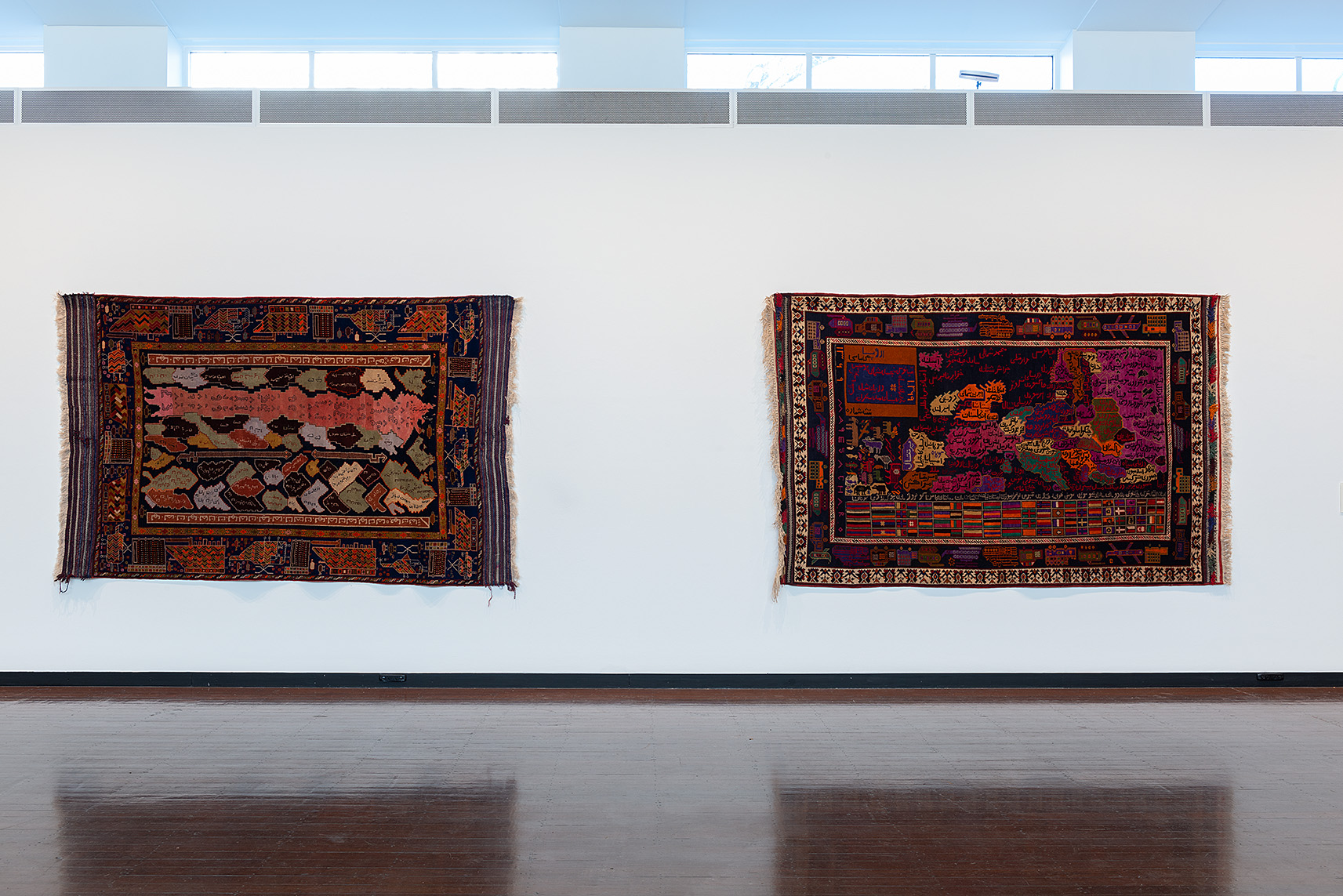
The exhibition has been extended in honor of Nigel Lendon, so get to ANU before November 14 to see special array of war rug. Also, make sure to get Nigel and Tim Bonyhady’s book, which is certain to be an important piece of war rug literature.

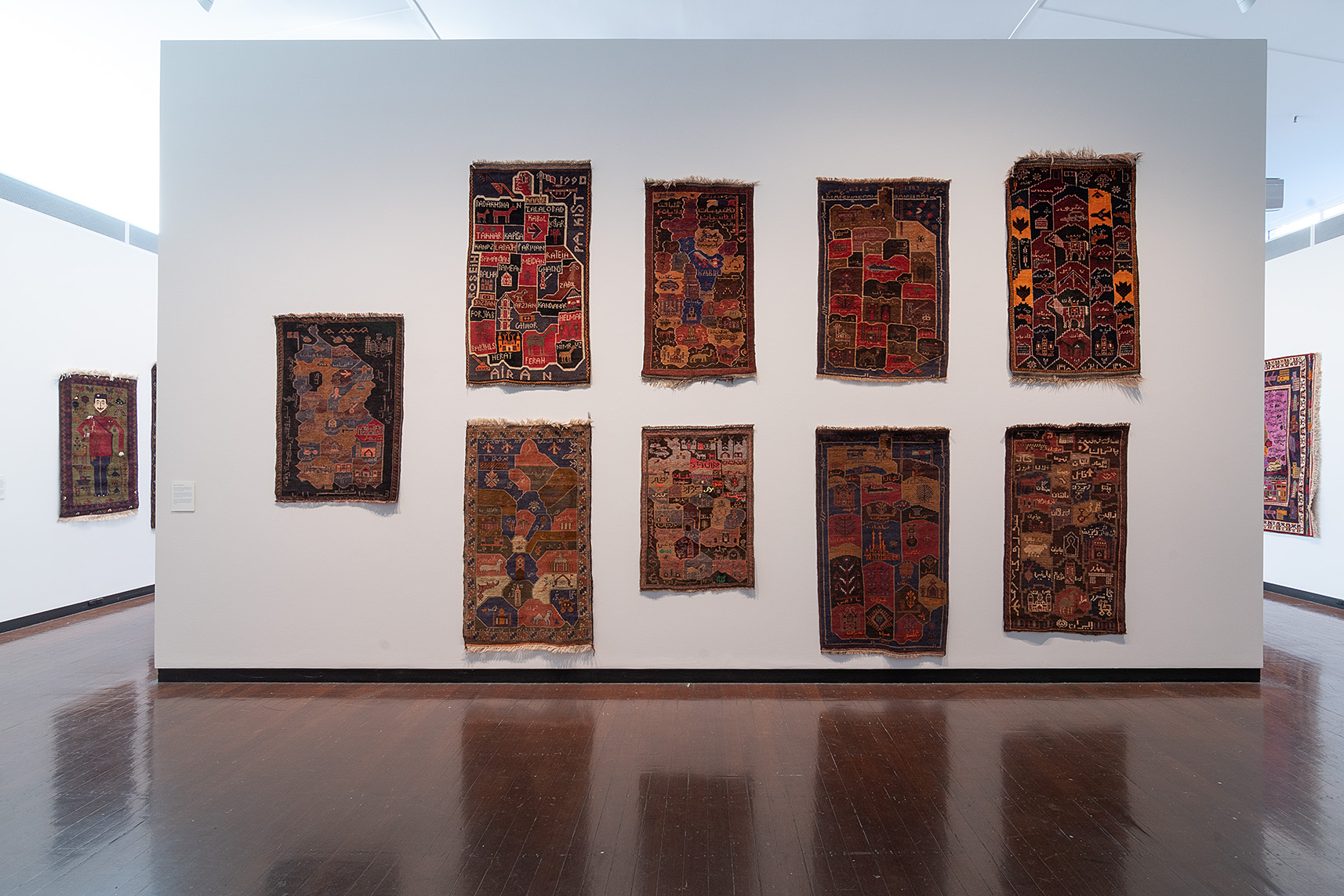
The Sad Loss of Nigel Lendon
It fills me with great sadness to learn of Nigel Lendon’s passing on October 24.
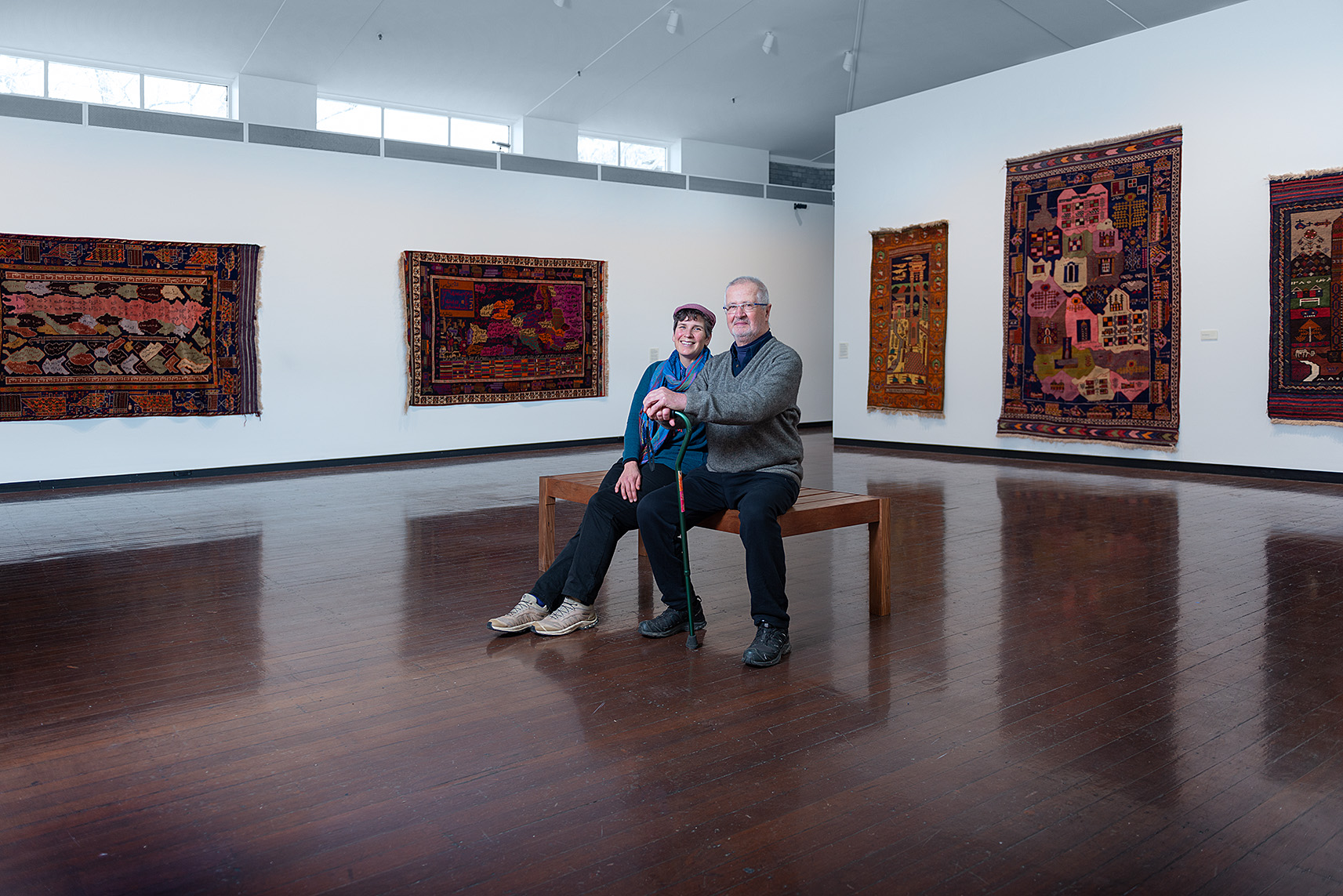
Nigel has done excellent and important work on war rugs, and his loss will be broadly felt.
Luca Brancati Book!

Im a rare treat and a historic piece of war rug history, Luca Emilio Brancati has published a book. He has a unique and historic collection, so this book promises to be fascinating. It is available here, but American shipping is not yet available.
Order his book here (embed removed to prevent ugly and unwanted javascript from running on our page)
I am super excited to see it, and I expect to learn a great deal. Very exciting!
Kabul Airport
Today the New York Times published a story about the status of the Afghan war, including this amazing photo by Kiana Hayeri.

The countless hours I have spent
looking for the view in these rugs
Cityscape in Springtime Rug
This is a rug that was sold before being properly inventoried, and recently I found these photos from 2004. If you happened to have bought this rug from me at the showroom in Long Island City, please contact me, for it would be good to get better quality photos.
What makes this rug so great? First, its depiction of spring in a city. The colors are lively and fresh. Second, it is a well drawn and clear Modern City Landscape, and maybe a key to identifying the location. Third, the drawing is very good with wonderful details: the plane, the motorcycle, the blooming trees. Fourth, the border is festive with strong rhythm. Enjoy!
Marled and Checkered Colors in Afghan Rugs
Afghan tribal rugs use two techniques to create “halftones”. The techniques are “checkered” knots and “marling”. Marled and checked colors function particularly well in landscape backgrounds.
CHECKERED COLORS
When individual knots alternate between colors (both vertically and horizontally) the result is a checkered color, like these examples:
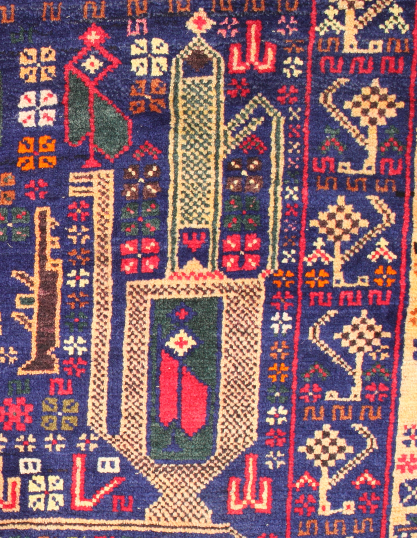
^ Rug #1065 ^
MARLED COLORS
Marled is two colors spun into one thread then woven into a carpet. It is more irregular and “blurry” than checkered colors.
(verso) ^ Rug #779 ^
^ Rug #1484 ^
Novel Take on a “Drone Rug”
While iRobot’s privacy policy is objectionable, the artist Johannah Herr’s use of a robotic vacuum is interesting and funny.

More info is about Johannah Herr’s “Drone Roomba” is here.
Vimeo video (linked rather than embedded to limit evil javascript from loading on our site)
